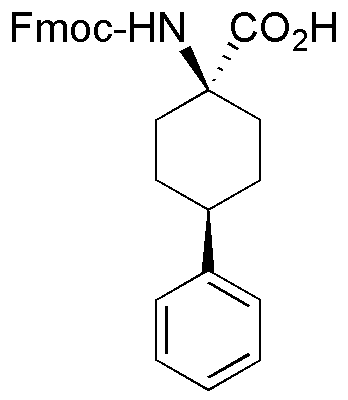Fmoc-cis-1-amino-4-phenyl-cyclohexane carboxylic acid is widely utilized in research focused on
- Peptide Synthesis: This compound serves as a key building block in the synthesis of peptides, allowing for the introduction of specific amino acid sequences that are crucial in drug development.
- Drug Development: Its unique structure aids in the design of novel pharmaceuticals, particularly in creating compounds that target specific biological pathways, enhancing therapeutic efficacy.
- Bioconjugation: The compound can be used in bioconjugation processes, where it helps to attach biomolecules to drugs, improving their delivery and effectiveness in targeted therapies.
- Research in Neuroscience: It plays a role in the study of neuroactive peptides, contributing to the understanding of neurological disorders and potential treatments.
- Material Science: The compound's properties can be exploited in the development of new materials, particularly in creating polymers with specific functionalities for industrial applications.
General Information
Properties
Safety and Regulations
Applications
Fmoc-cis-1-amino-4-phenyl-cyclohexane carboxylic acid is widely utilized in research focused on
- Peptide Synthesis: This compound serves as a key building block in the synthesis of peptides, allowing for the introduction of specific amino acid sequences that are crucial in drug development.
- Drug Development: Its unique structure aids in the design of novel pharmaceuticals, particularly in creating compounds that target specific biological pathways, enhancing therapeutic efficacy.
- Bioconjugation: The compound can be used in bioconjugation processes, where it helps to attach biomolecules to drugs, improving their delivery and effectiveness in targeted therapies.
- Research in Neuroscience: It plays a role in the study of neuroactive peptides, contributing to the understanding of neurological disorders and potential treatments.
- Material Science: The compound's properties can be exploited in the development of new materials, particularly in creating polymers with specific functionalities for industrial applications.
Documents
Safety Data Sheets (SDS)
The SDS provides comprehensive safety information on handling, storage, and disposal of the product.
Product Specification (PS)
The PS provides a comprehensive breakdown of the product’s properties, including chemical composition, physical state, purity, and storage requirements. It also details acceptable quality ranges and the product's intended applications.
Certificates of Analysis (COA)
Search for Certificates of Analysis (COA) by entering the products Lot Number. Lot and Batch Numbers can be found on a product’s label following the words ‘Lot’ or ‘Batch’.
*Catalog Number
*Lot Number
Certificates Of Origin (COO)
This COO confirms the country where the product was manufactured, and also details the materials and components used in it and whether it is derived from natural, synthetic, or other specific sources. This certificate may be required for customs, trade, and regulatory compliance.
*Catalog Number
*Lot Number
Safety Data Sheets (SDS)
The SDS provides comprehensive safety information on handling, storage, and disposal of the product.
DownloadProduct Specification (PS)
The PS provides a comprehensive breakdown of the product’s properties, including chemical composition, physical state, purity, and storage requirements. It also details acceptable quality ranges and the product's intended applications.
DownloadCertificates of Analysis (COA)
Search for Certificates of Analysis (COA) by entering the products Lot Number. Lot and Batch Numbers can be found on a product’s label following the words ‘Lot’ or ‘Batch’.
*Catalog Number
*Lot Number
Certificates Of Origin (COO)
This COO confirms the country where the product was manufactured, and also details the materials and components used in it and whether it is derived from natural, synthetic, or other specific sources. This certificate may be required for customs, trade, and regulatory compliance.


